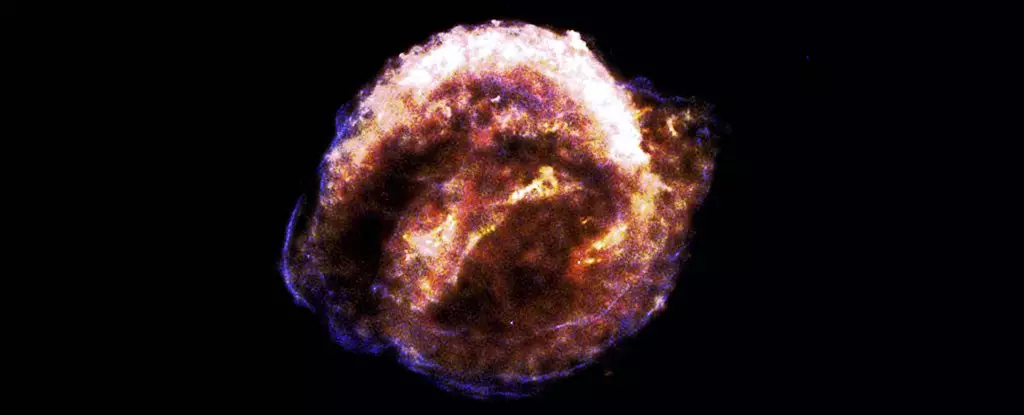In the grand theater of the universe, the explosive deaths of massive stars, known as supernovae, play a pivotal role in shaping the cosmic landscape. These cataclysmic events are not merely spectacular light shows; they serve as fundamental processes that contribute to the distribution of heavy elements throughout space. Most notably, the remnants from these explosions, such as iron isotopes like Fe60, are found embedded in the sediments of Earth’s seafloor. Recent research has unveiled intriguing insights into the potential ramifications of these celestial explosions on terrestrial life, suggesting that supernovae might have profoundly influenced the biodiversity and evolutionary pathways on Earth.
Scientists have pinpointed the origins of two significant deposits of Fe60 in oceanic sediments dating back two to six million years. The younger accumulation—approximately two to three million years old—is attributed directly to a distant supernova explosion. Meanwhile, the older accumulation, dating to five or six million years ago, is believed to be the result of Earth’s passage through a vast interstellar bubble generated by massive stars known as OB stars. These stars, known for their intense heat and short lifespan, contribute to the creation of hot gas bubbles in the interstellar medium through their dynamic stellar winds.
Our Solar System resides within one such bubble called the Local Bubble, which spans nearly 1,000 light-years and is a remnant of previous supernovae. The entrance of our Solar System into this bubble may have played a crucial role in the accumulation of Fe60 found in ancient sediment layers. The research presented in the Astrophysical Journal Letters highlights the significant role of supernovae in shaping both the cosmos and life on our planet.
Radiation Penetrates Life’s Fabric
The implications of supernovae extend beyond mere elemental contributions; they have the potential to significantly increase radiation levels that impact Earth’s surface. As outlined by the research team led by Caitlyn Nojiri from UC Santa Cruz, the ferocity of cosmic radiation generated by these explosions can vary dramatically as our Solar System navigates through different regions of the galaxy. The authors emphasize that even though terrestrial radiation has been diminishing over billions of years, cosmic radiation remains a constant yet fluctuating influence, particularly in the wake of nearby supernova activity.
Understanding the extent to which increased cosmic radiation can affect life is challenging. The researchers propose that doses from supernovae could lead to critical biological changes, such as double-strand breaks in DNA, a form of damage that could trigger mutations and catalyze species diversification. Notably, evidence suggests that the rates of viral diversification in certain ecosystems, such as African lakes, have accelerated during the last several million years, potentially aligning with periods of increased cosmic radiation.
While the energy emitted during supernovae has the potential for catastrophic biological consequences, it also poses unique opportunities for evolution. The researchers pose the question: could the heightened radiation experienced during critical evolutionary epochs be a catalyst for increased mutation rates, thus spurring biodiversity? The findings suggest that while the radiation levels might not have been sufficient to spur mass extinction events, they could have favored the emergence of new species through elevated mutation rates.
This intricate balancing act—where radiation can function both as a destructive force and a driving factor in evolution—highlights the complexity of cosmic influences on biological life. As the researchers aptly conclude, understanding the thresholds that could transform radiation from being harmful to beneficial remains elusive. The authors call attention to the necessity for further exploration of cosmic radiation, particularly regarding how muons—the particles that dominate at Earth’s surface—interact with biological systems.
Cosmic Context: Life’s Interconnectedness
The exploration of supernovae reveals a deeper interconnectedness between life on Earth and the cosmos at large. It is a profound reminder that the cosmic environment plays an active role in shaping our biological narrative, albeit in ways that we may not consciously perceive. The idea that the very fabric of life could be molded by the energy and elements birthed from stellar explosions challenges our understanding of evolution and life’s adaptability.
As we forge ahead in our comprehension of cosmic radiation’s role in evolutionary biology, one cannot help but ponder how many more secrets the universe holds regarding life’s formation and development. The research indicates that, while we are often oblivious to the cosmic forces at play, the legacy of supernovae can be traced through the annals of Earth’s history, fundamentally influencing the trajectory of life as we know it.
The reverberations of supernova explosions extend far beyond the immediate spectacle they provide in the night sky. Their remnants are woven into the very fabric of the Earth, influencing evolutionary pathways and ecological diversity. Through ongoing research, we inch closer to understanding how these astronomical phenomena have sculpted life on our planet, revealing the importance of cosmic events as pivotal players in the story of Earth’s biological evolution. The details may be complex and multifaceted, yet the fundamental theme remains clear: the universe, in all its vastness, plays an integral role in life’s unfolding.

